2.7.4.1. Composite polygonal items: drawing techniques
- 2.7.4.1.1. Draw an item that consists of one polygon and doesn't share borders with other polygons
- 2.7.4.1.2. Adding an internal polygon to an item
- 2.7.4.1.3. Creating an item consisting of multiple polygons without shared borders
- 2.7.4.1.3.1. Adding a new external polygon to an item
- 2.7.4.1.3.2. Adding an existing external polygon to an item
- 2.7.4.1.4. Duplicate shared sections of border (snapping mode)
- 2.7.4.1.5. Drawing items that share several border sections with other polygons
2.7.4.1.1. Draw an item that consists of one polygon and doesn't share borders with other polygons
To draw a composite polygonal item that consists of one polygon (and doesn't share borders with other items of the same type):
-
Click the appropriate button in the toolbar.
For example, Administrative division
 .
.The attribute panel for the map item opens (
Administrative division
):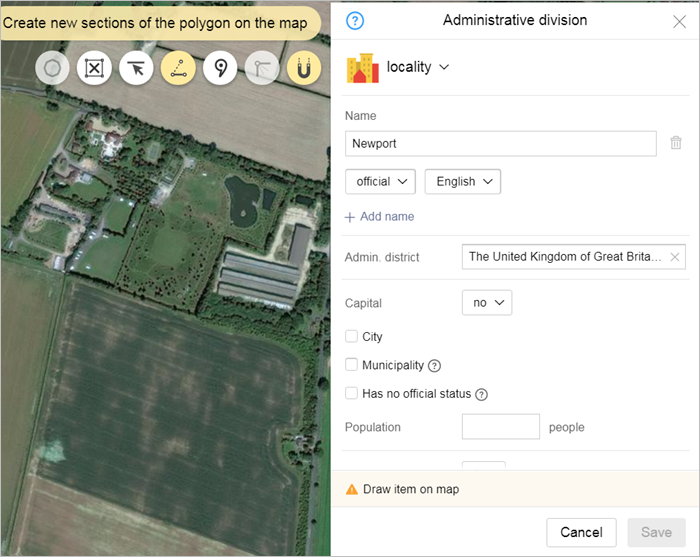
Additionally, you will see a local toolbar that contains buttons (active buttons are orange, inactive buttons are white):
 — Add/exclude existing sections mode. When this mode is active, clicking on sections of the border will either add them to the map item or exclude them from it.
— Add/exclude existing sections mode. When this mode is active, clicking on sections of the border will either add them to the map item or exclude them from it.
 — Draw new polygon sections mode.
— Draw new polygon sections mode.
 — Snap to other map items mode. In this mode, the vertexes of the new item snap to neighboring polygons that were drawn earlier. This mode is used if, for example, you are drawing administrative divisions that have shared borders.
— Snap to other map items mode. In this mode, the vertexes of the new item snap to neighboring polygons that were drawn earlier. This mode is used if, for example, you are drawing administrative divisions that have shared borders.
 — Indicate or change center of item. This button is only found in the local toolbar for items in the
— Indicate or change center of item. This button is only found in the local toolbar for items in the Administrative division
andVegetation
categories. For more information, see sections 3.2.3. Drawing centers of administrative divisions and 3.9.3. Drawing the center of a vegetation object. -
Draw the item outline.
The same rules apply to drawing both simple polygons:
-
Click on the spot where you want to start drawing your polygon. A polygon vertex will appear in the point as a circle on the map.
The cursor will turn into a cross and you can move it to continue drawing your polygon.
-
Move the cursor to the next point of your polygon and click to set it. A new vertex will appear at that point.
Finish your drawing by clicking on the starting point of your polygon (the Finish option will display on your screen):
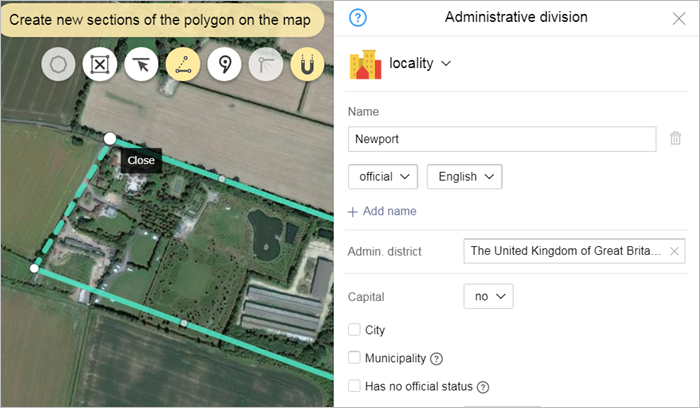
In the middle of segments created by two consecutive vertices, you'll see points that you can use to bend the line (see Section 2.7.4.2.3. Adding a vertex).
Click on any of vertexes to open the context menu:
- Delete — delete the vertex that is currently selected.
- Continue — continue drawing a polygon that was previously "finished" (starting from the point that opened the menu).
- Make angle 90° — to make the selected vertex 90°.
- Round the corner — round the vertex.
- Round all corners — round all vertices.
- Open — open the polygon you drew at the selected vertex.
- Set the operation starting point — set the first point for editing.
- Add new section of polygon — lets you add a new section of an outline that is part of an item. When you do this, sections that were drawn earlier are saved on the map. This feature is only used when you create items that include sections of shared border.
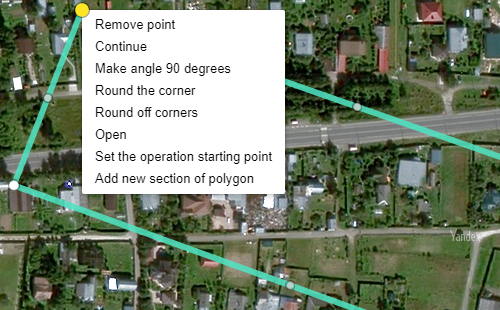
The context menu commands are used for editing the item (see Section 2.7.4.2. Complex contour object: editing techniques).
-
-
Use the attribute panel to add values to item attributes (for information on assigning attributes to specific categories of items, see Section3.1. General rule):
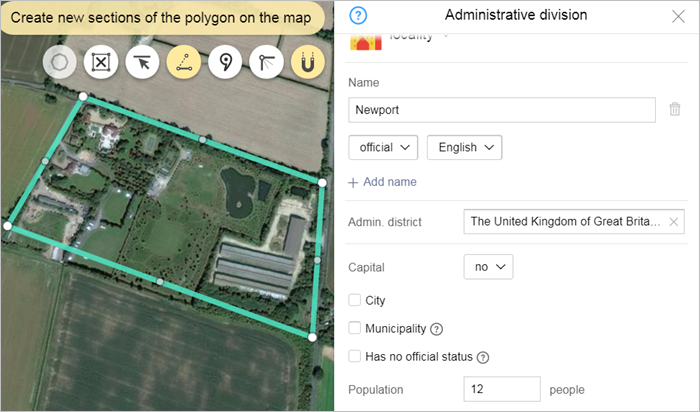
-
Click Save to save the polygon you drew:
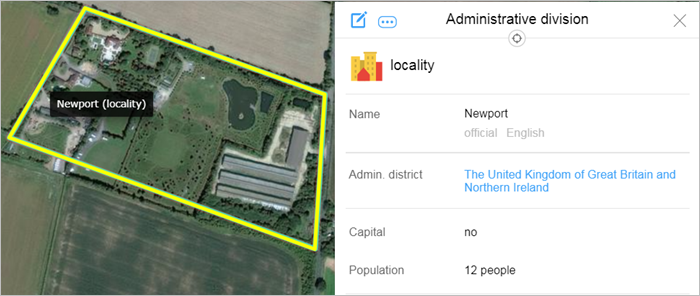
2.7.4.1.2. Adding an internal polygon to an item
If a mother polygon (item 1
) contains another item (item 2
) that is of the same category but belongs to an item type that doesn't fit in that category, then draw that item (item 2
) as an internal polygon within the mother polygon (item 1
). Also see Section 2.7.2. Rules for using internal polygons.
For example, paths or clearings may be represented as internal polygons on woodlands territory (because they are items from the Vegetation
category that don't belong to one of the types of that category).
To add an internal polygon to a polygon:
-
Select the item on the map. The attribute panel for the map item opens:

-
Click Edit
 on the panel (or use Ctrl + E). The item and attribute panel will switch to editing mode.
on the panel (or use Ctrl + E). The item and attribute panel will switch to editing mode. -
Click Add internal polygon
 .
. -
Draw the internal polygon (much like you drew the main polygon): When drawing, make sure that the borders of the internal polygon don't intersect with those of the external one:

-
Click Save to save the polygon you drew.
The item will be saved as a pair of polygons (the main one and the internal one). Vegetation displays on the map as a dotted line:
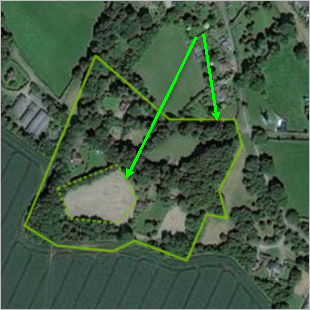
2.7.4.1.3. Creating an item consisting of multiple polygons without shared borders
You can draw an item that consists of two or more polygons that don't share borders with other polygons in one of two ways:
- Draw one of the polygons and then (without exiting map item drawing mode) draw the second one as part of the first item (by adding a new external polygon to the item). See 2.7.4.1.3.1. Add a new external polygon to an item.
- Draw each polygon and then join them together into one item. See 2.7.4.1.3.2. Add an existing external polygon to an item.
2.7.4.1.3.1. Adding a new external polygon to an item
To add a new external polygon to an item that was created earlier:
-
Select the polygonal item on the map. The attribute panel for the map item opens (for example,
Administrative division
):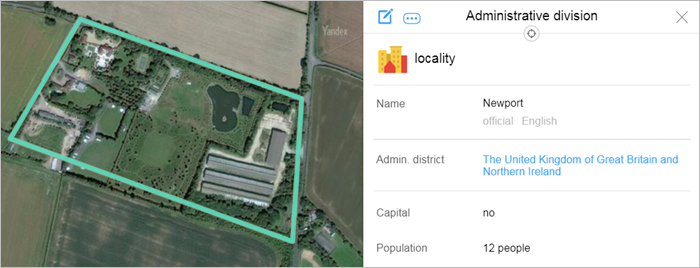
-
In the attribute panel that opens, click Edit
 .
.The item and attribute panel will switch to editing mode:
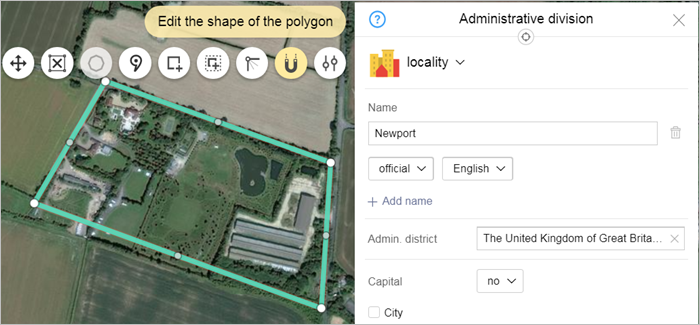
-
Click
 (Add external polygon). The toolbar will change its appearance. Click
(Add external polygon). The toolbar will change its appearance. Click  (Draw new polygon sections mode):
(Draw new polygon sections mode):
-
Draw a new external polygon:

-
After you save the item, it will include both polygons:
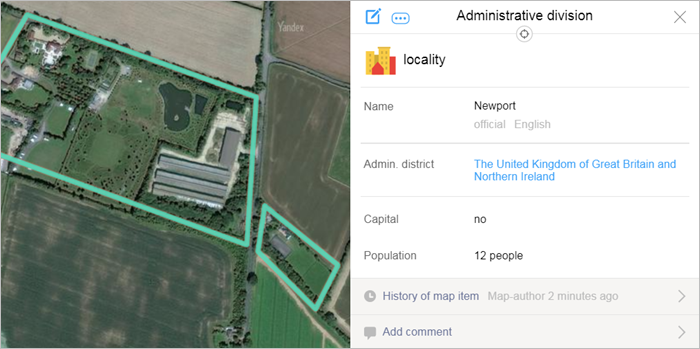
2.7.4.1.3.2. Adding an existing external polygon to an item
To add an external polygon that was drawn earlier to an item:
-
Select the polygonal item on the map. The attribute panel for the map item opens (for example,
Administrative division
):
-
In the attribute panel that opens, click Edit
 .
.The item and attribute panel will switch to editing mode:

-
Click
 (Add external polygon).
(Add external polygon). -
The toolbar will change its appearance.
Click
 (Add/exclude existing sections mode) in the local toolbar:
(Add/exclude existing sections mode) in the local toolbar:
-
Click on the appropriate part of the polygon to select the polygon you are adding:
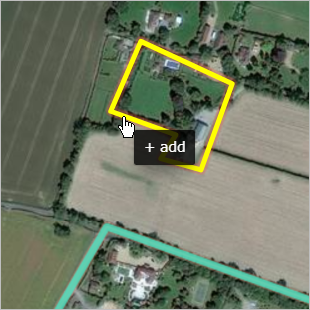
-
After you save the item, it will include both polygons:
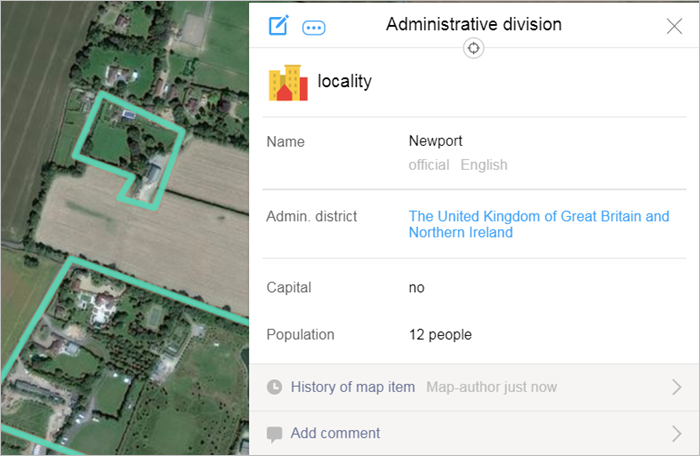
2.7.4.1.4. Duplicate shared sections of border (snapping mode
)
When you draw or edit vegetation, hydrography, terrain, and administrative division polygonal items that share sections of border with other polygons (including with those of other categories such as woodlands and the rivers that flow within its borders), you can duplicate the shared sections of borders using snapping
mode. This ensures that they completely coincide.
For example, you can use this technique to draw shared borders for:
- Islands or peninsulas and reservoirs
- Bodies of water and woodlands
- Reservoirs and borders of localities
When Snapping mode is enabled, the  button displays when you click it:
button displays when you click it:  .
.
Let's say that vegetation and hydrography items share a border but the map shows a gap between them.
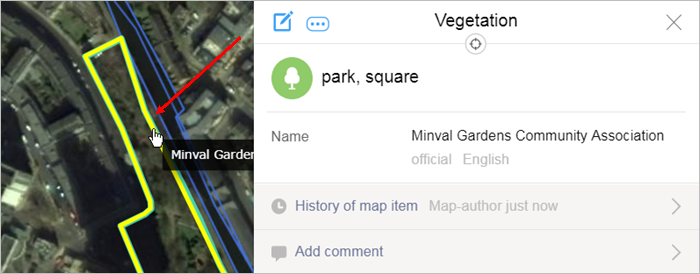

We want to get rid of this gap. To do this, draw a new polygon or edit an existing one so that the borders of these neighboring items coincide.
For example, the river floodplain in the drawing caused the gap between polygons, so it should be added to the river item. When you draw and edit duplicate border sections, they snap together (and the existing polygon turns white):

When drawing (editing) overlapping border sections, they visually merge into one item and the gap between them disappears. However, this does not mean that they join to form a single item. If necessary, you can still select and edit the items separately.
If you have to draw two close polygons with a gap between them, just click Snap to other map items mode to disable it (it looks like
to disable it (it looks like  when deactivated).
when deactivated).
2.7.4.1.5. Drawing items that share several border sections with other polygons
To draw an item that shares several border sections with other polygons:
-
Click the appropriate button in the toolbar.
For example, Administrative division
 .
.The attribute panel for the map item opens (
Administrative division
): -
Draw a new polygon that shares several border sections with other polygons (green arrow on the drawing) and exclude border sections that were drawn earlier (and are part of polygons that were drawn earlier (blue arrows on the drawing)):

When you move your cursor in drawing mode towards the border of a polygon that was drawn earlier, your cursor will pull towards that section. If you put your cursor on the border of the polygon, it changes colors.
-
Click
 (Add/exclude existing sections mode).
(Add/exclude existing sections mode).Select the section of border that you want to add to the polygonal item:
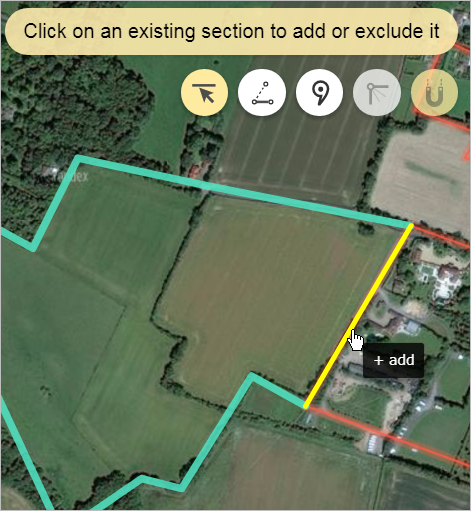
Sections that you want add to your item may belong to several different items.
If you click on the section that you added to the item again, it will be excluded from the item.
-
If the new item contains multiple separate new border sections, then after you draw the first one, use the Add new section of polygon command in the context menu to add other sections (the Draw new sections
 mode should be on). This way you can draw items whose borders alternate between new and previously drawn sections. For example:
mode should be on). This way you can draw items whose borders alternate between new and previously drawn sections. For example:
-
After you select all the border sections, assign attributes to your item. Rules for adding attributes to specific categories of items can be found in Section 3.1. General rule.
Click Save to save the polygon you drew:
